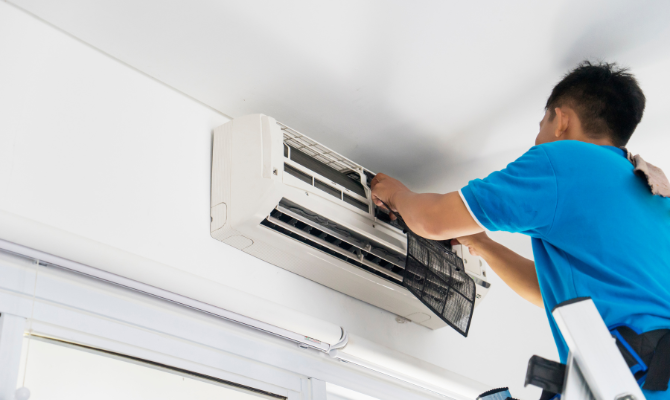In the past, people used to live in houses without any type of heating or cooling system. They would have to rely on the weather to determine how comfortable their home would be.
On a hot day, they would open the windows and doors to let in the cool breeze. On a cold day, they would build a fire in the fireplace to warm up their home.

This was often ineffective and resulted in extreme temperature fluctuations. Today, people rely on HVAC systems to maintain a comfortable temperature in their homes. HVAC systems are not only more effective than natural ventilation, but they also allow people to control the temperature in their homes more precisely.
What Is an HVAC?
An HVAC (heating, ventilation, and air conditioning) system is a machine that helps control the temperature and humidity in a building. It’s usually situated near the windows and helps to regulate airflow throughout the building.
In most cases, an HVAC system will consist of three parts: an air conditioner, a furnace, and ducting. The air conditioner uses cooling technology to lower the temperature inside the building while the furnace warms up the room with heat.
This combination allows the HVAC system to maintain an appropriate climate for all users in the building.
Read Also:
HVAC System Installation
When it comes to doing an HVAC installation, the size of the space, the climate, and the kind of system all need to be considered.
To determine the size of the space, you’ll need to figure out how much air conditioning is required. This will depend on a number of factors, like the climate in which your home is located and the type of system that you’re using.
For instance, if you live in a warm climate and use a fan-based system, then you’ll only need half as much air conditioning as someone living in a colder climate who’s using an AC unit based on refrigerants.
Similarly, if your home has more than one floor or room, then each one will need its own air conditioning unit. And finally, if your home has ductwork and wiring already in place (like many older homes do), then you won’t need to install any additional components.
Once you have the correct size, the next step is to choose a location for the unit. It’s essential to choose a location that is close to an exterior wall and away from any windows or doors. After you’ve selected the perfect location, it’s time to install the actual unit.
However, if your home doesn’t have any built-in ductwork or wiring (or if you want to upgrade them), then you’ll need to consult an HVAC contractor about what kind of system would work best for your situation.
If you are based in Dallas, you can find a lot of Dallas HVAC installation services. And finally, make sure to do your due diligence and choose a contractor who is experienced with installing AC systems in homes with specific features like high ceilings or big windows.
How Does HVAC Operate?
The three primary components of an HVAC system are a furnace, an AC, and a ductwork system.
The furnace heats air and then blows it through the ductwork system to various rooms in the house. The air conditioner cools and dehumidifies the air before it is blown through the ductwork system.
The ductwork system distributes the conditioned air throughout the house. It consists of a network of supply and returns ducts that connect to the furnace and air conditioner.
Supply ducts carry conditioned air from the furnace or air conditioner to the rooms in the house. Return ducts bring unconditioned air back to the furnace or air conditioner to be reconditioned.
The HVAC Installation Cost
The average cost to install a new HVAC system is $3,500. However, the cost can range from $2,000 to $11,000, depending on the size of the unit and the complexity of the installation. The cost of labor will also vary depending on the experience of the installer and the location of the home.
The most essential factor in determining the cost of a new HVAC system is the size of the unit.
The greater the size, the more expensive the unit will be to install. The model of the unit you choose will also affect the expense. And central air units are generally more expensive than window units.
The complexity of the installation is another important factor in determining the cost. If your home does not have an existing duct system, then installing a new one will be more expensive.
The Types of HVAC Installation
There are three main types of HVAC installations: a central air system, a split system, and which consists of two units: an outdoor unit and an indoor unit.
The central air system is the most common type of HVAC installation. It’s a centralized system in which one unit (the outdoor unit) blows air into every room in your house.
The indoor unit extracts heat from the rooms and sends it to the outdoor unit, where it’s blown back out into the rooms. This type of installation is usually cheaper than a split system or which consists of two units because you only need one furnace instead of two.
The HVAC mini split system is a type of HVAC installation in which the indoor and outdoor units are separate. Each unit has its own ducts and fan so that it can handle colder or hotter air differently.
This makes it better for climates that change a lot (like coastal areas) because you don’t have to waste energy by sending cold air into warm areas or vice versa.
And finally, Ductless split systems are one of the most popular types of HVAC installation because they’re easy to use and install. You simply connect the system to your home’s wiring, and you’re ready to go. They also have a low energy consumption, making them environmentally friendly.
Conclusion
HVAC is a crucial part of any building, and its operation is vital to the comfort of the occupants. The system is made up of various components that work together to provide these services.
HVAC systems are designed to operate in various climates and can be customized to meet the specific needs of a building. By understanding how it works, you can ensure that your HVAC system is operating efficiently and effectively.









